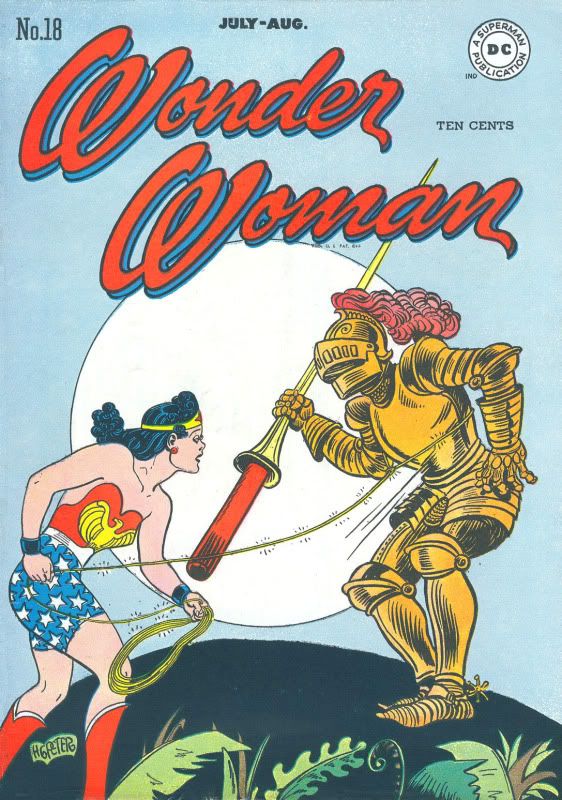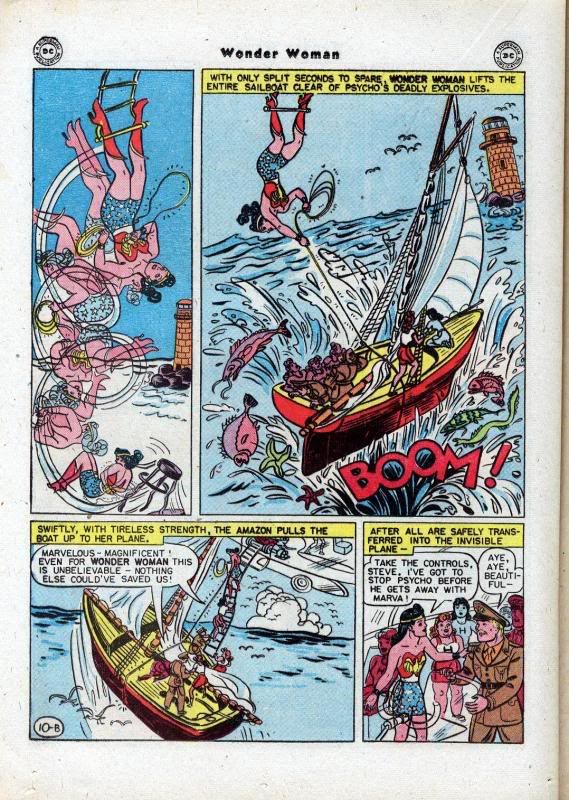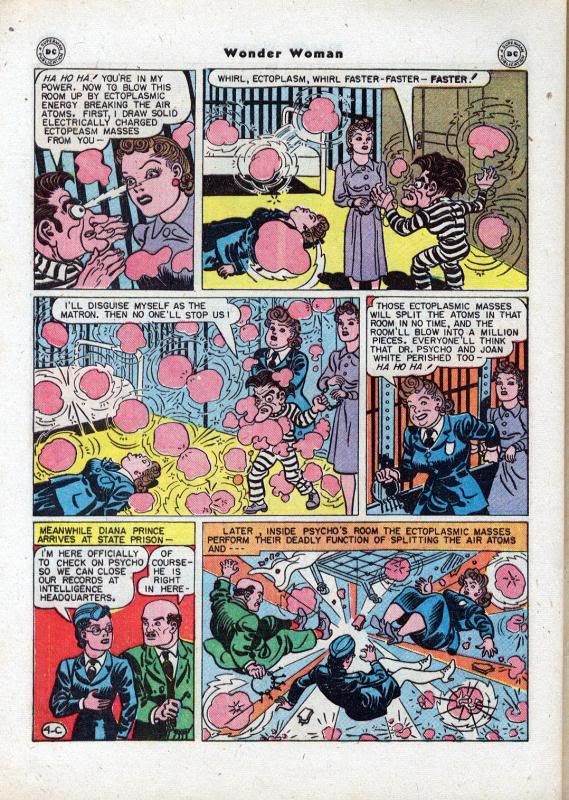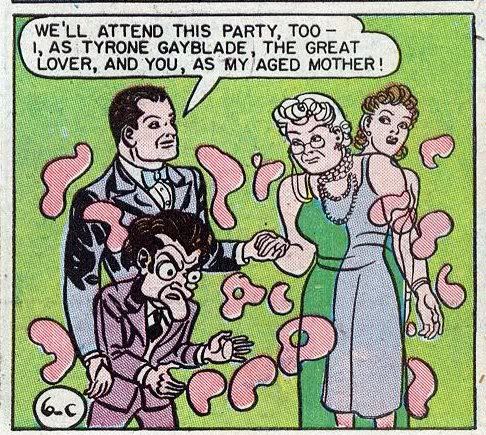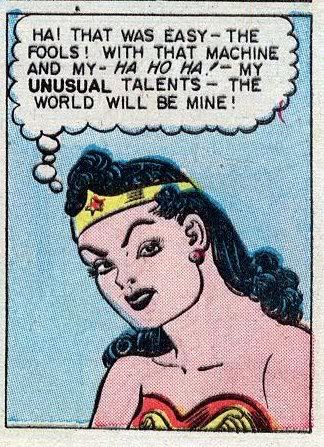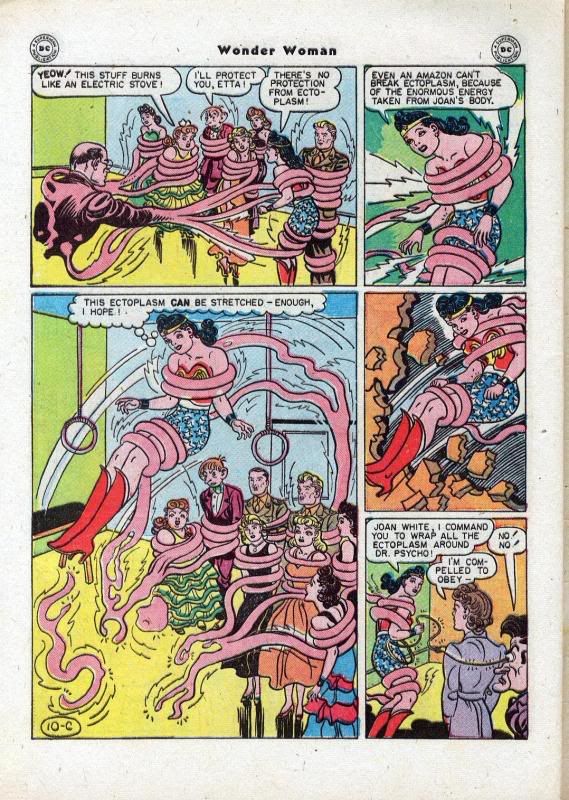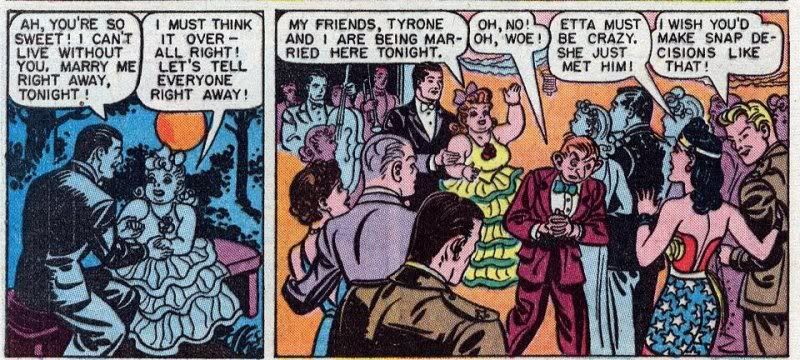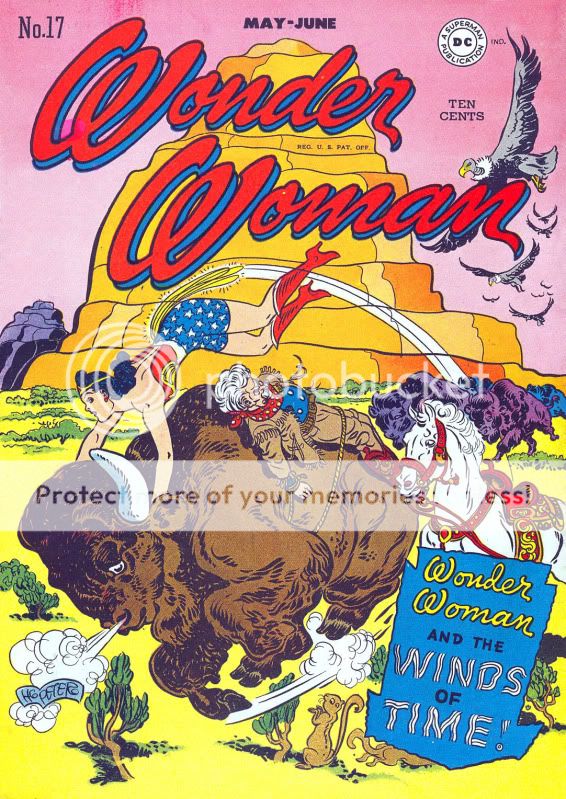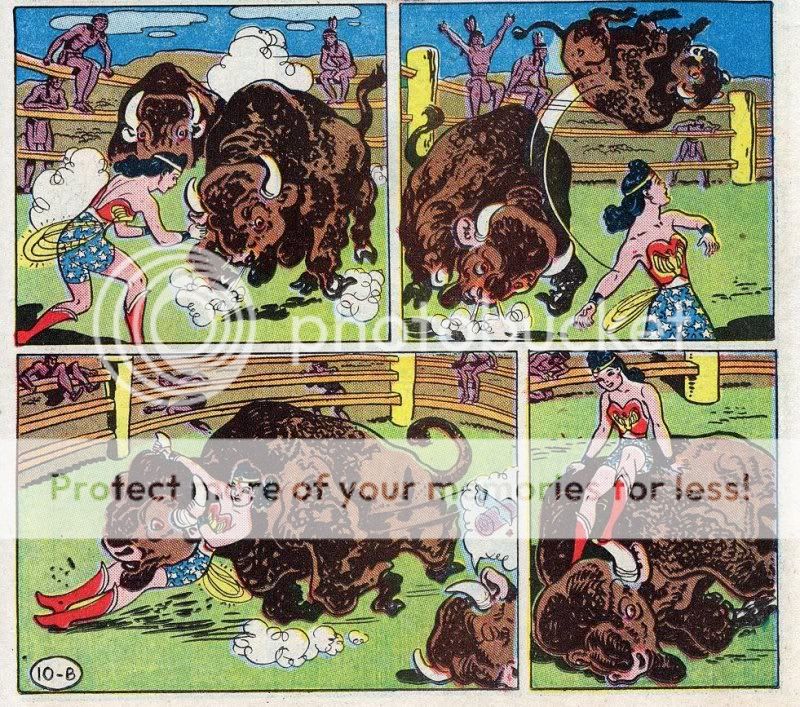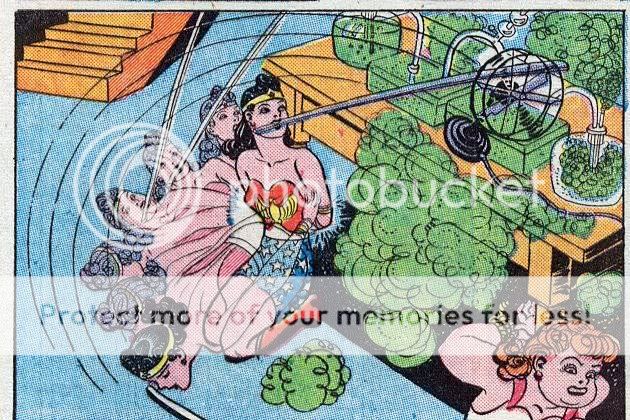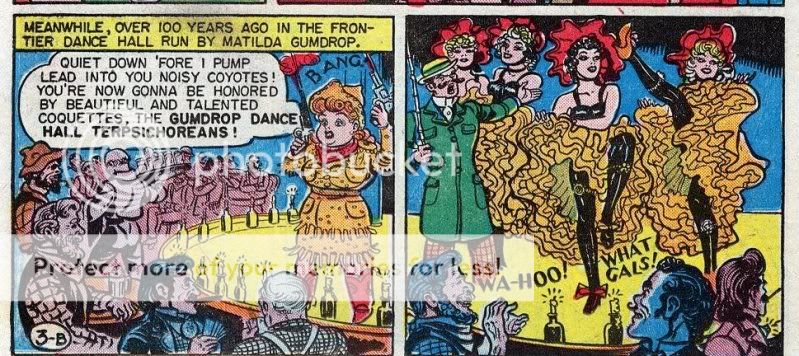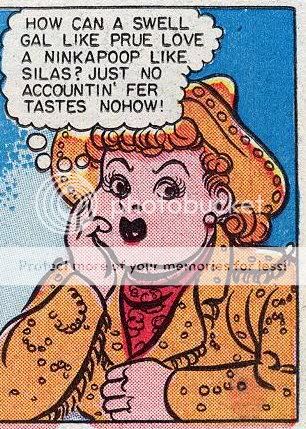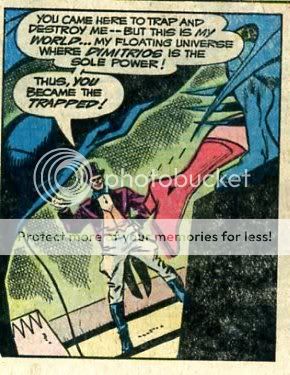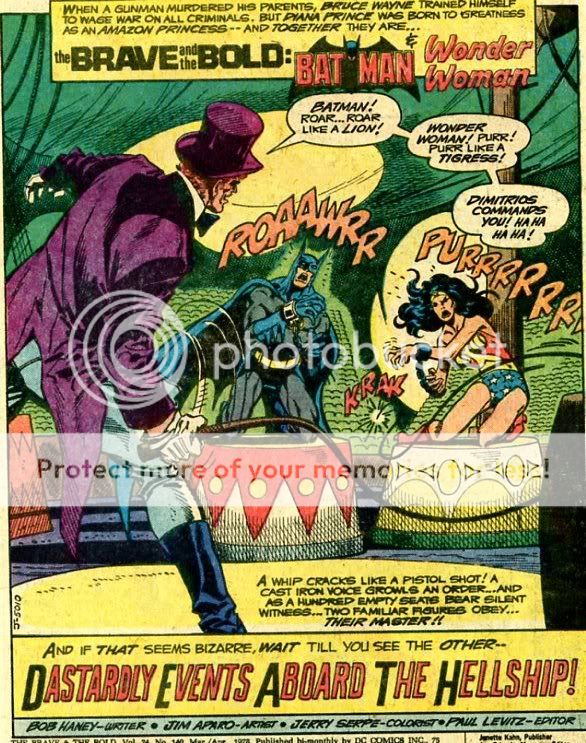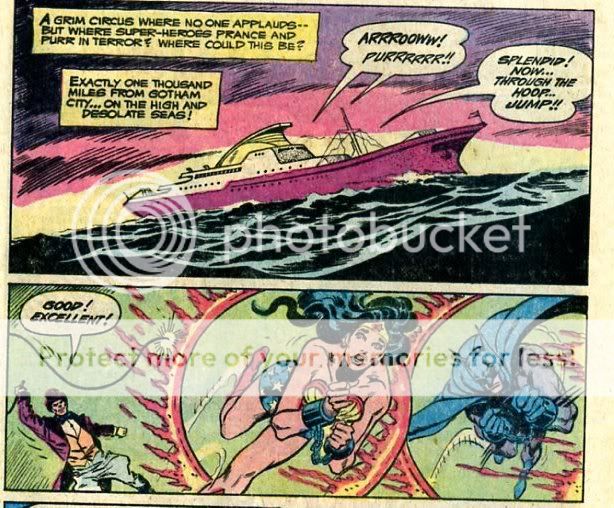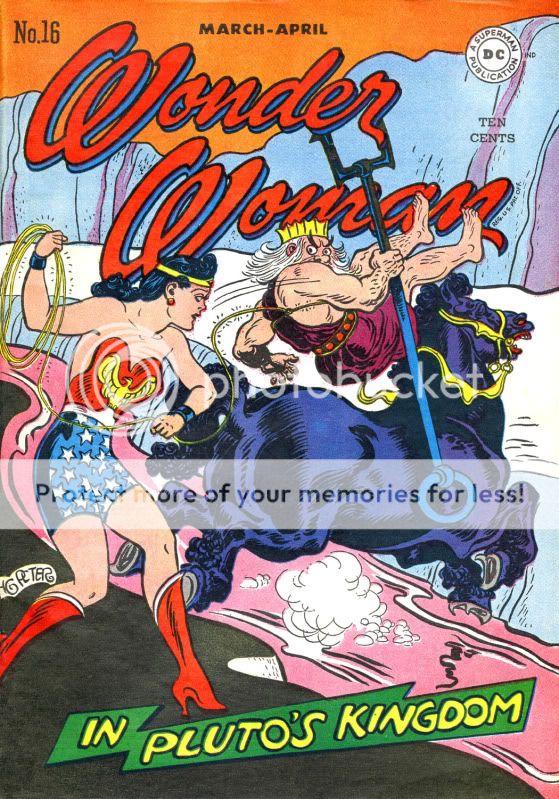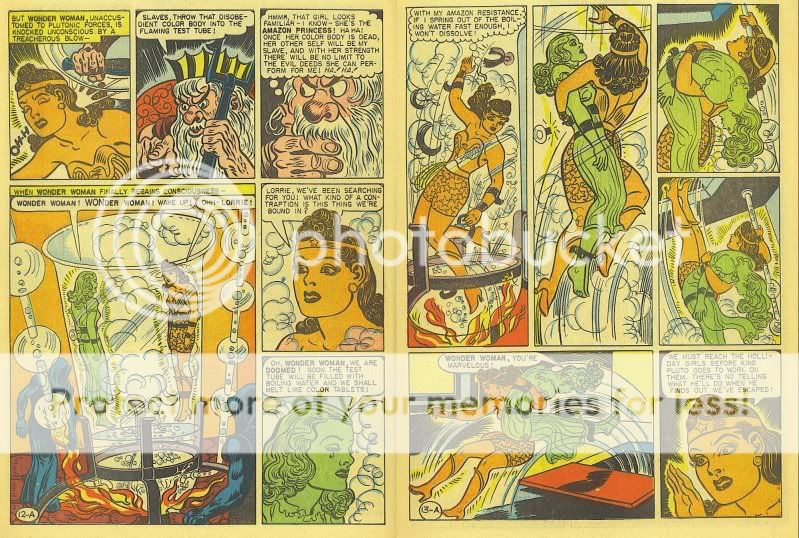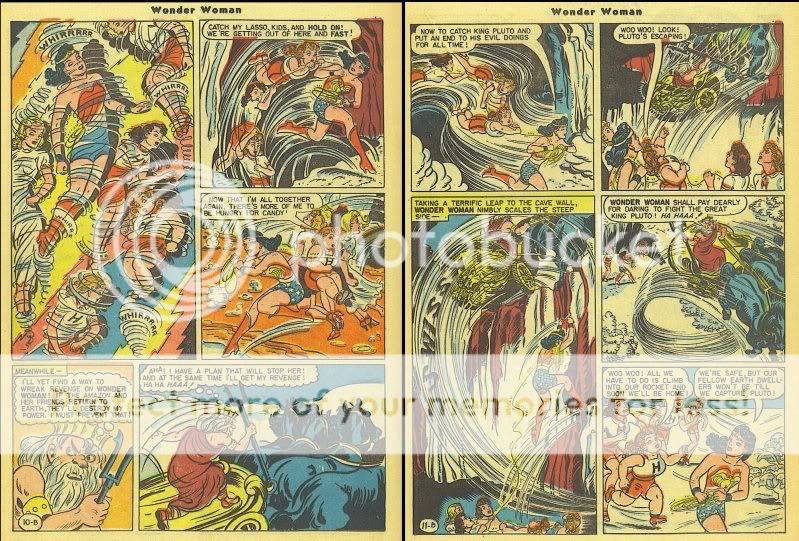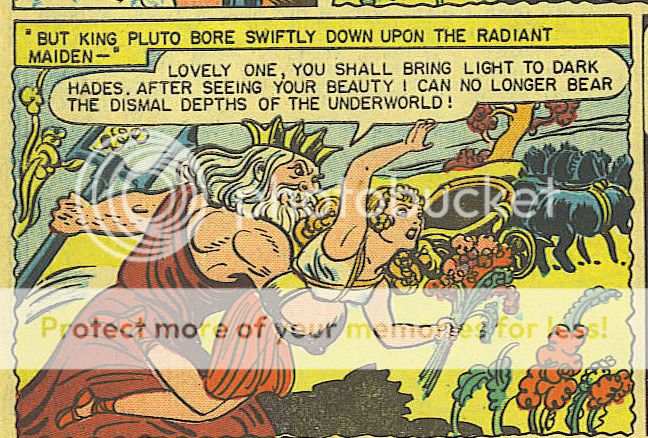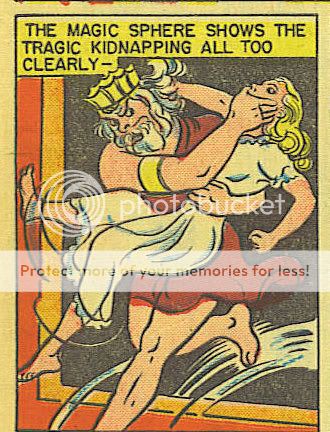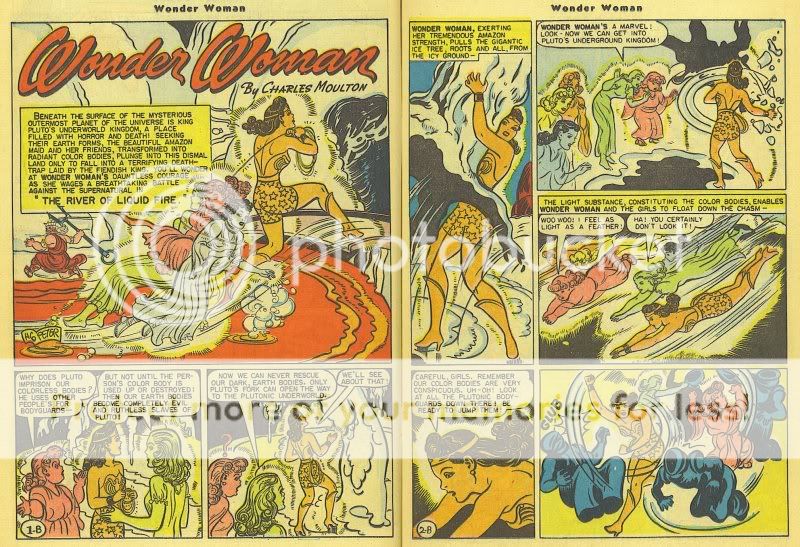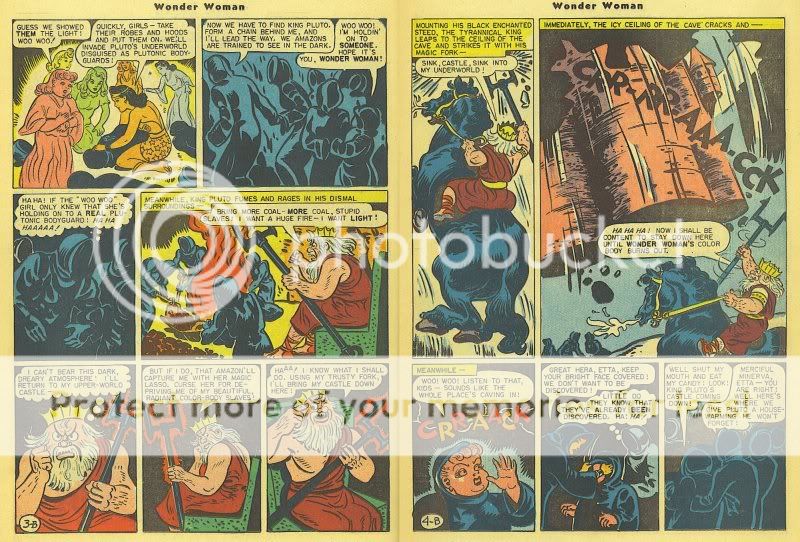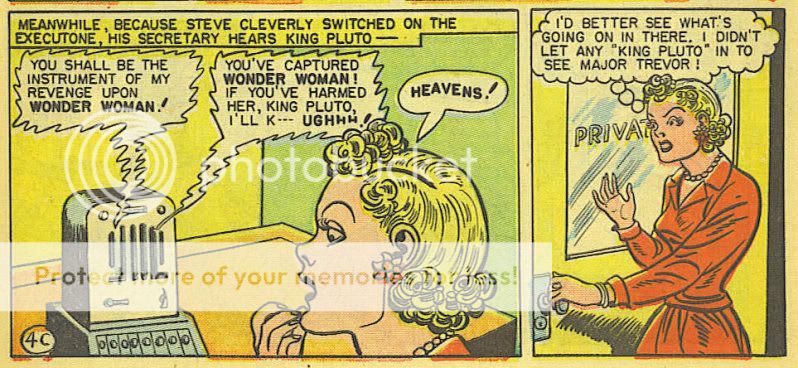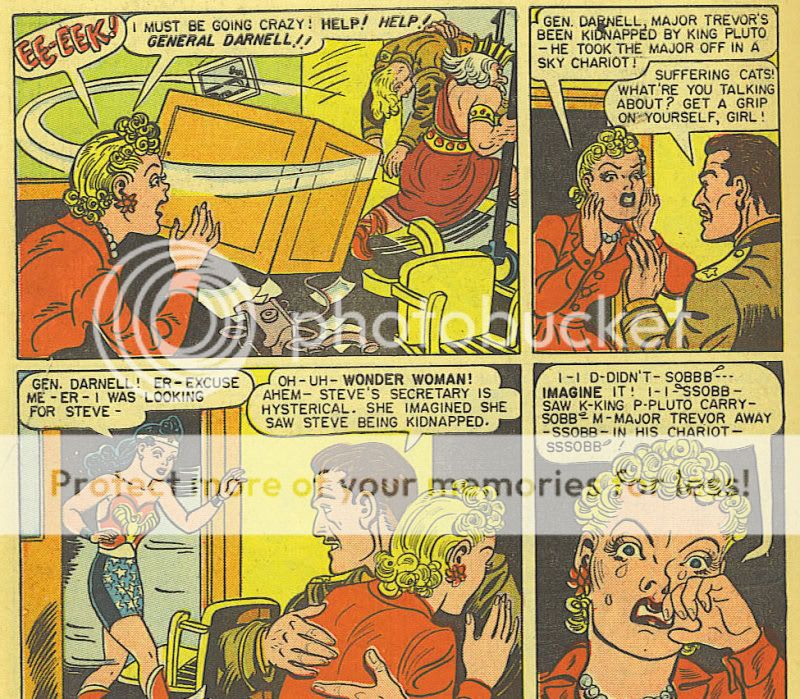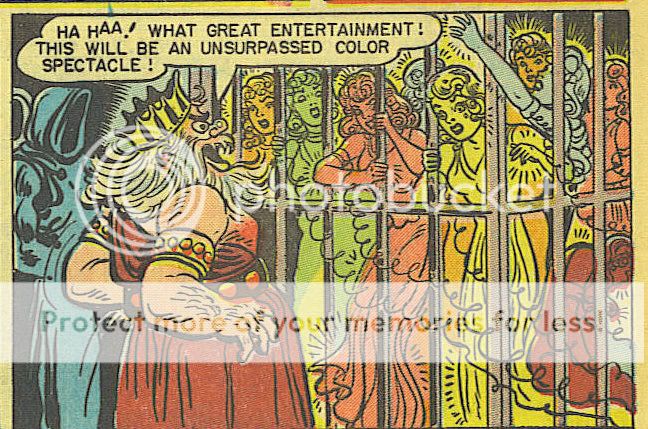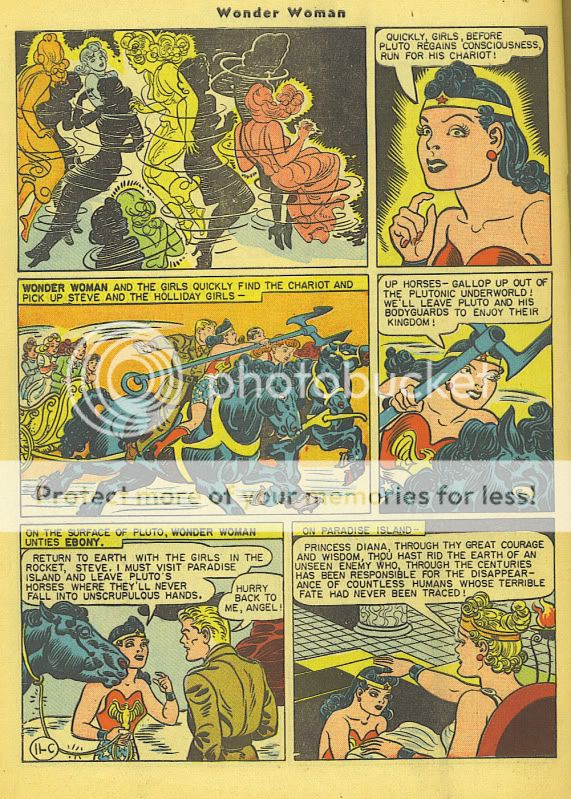I’ve mentioned this before, but it is now upon us: I’m going to be giving a talk on feminism, bondage, Wonder Woman, and Marston crackpottery at Randolph-Macon College in Virginia. If you happen to be in those parts, come on by — it’s tomorrow, the 28th, at 7:30 (all relevant info is here.)
Tag Archives: Wonder Woman
Bound to Blog: Wonder Woman #18
That’s a kind of generic cover for Peter; the knight’s certainly nicely drawn (love that plume), but overall it’s fairly static and boring by his standards. Part of that may be that it’s trying to be coy: Marston/Peter have a secret return villain, and they don’t want to give it away. But here I come spoiling it 60 years later: the villain in this issue is:
Remember him from Issue #5? Little dwarf guy? Hated women so hypnotized them to cause them to send forth ectoplasm so he could take on different shapes? How could you forget, right?
Well, anyway, as so often happens with sequels, this one isn’t nearly as much fun as the original. No giant space kangas, for instance. No battle with Ares (who was originally using Psycho to prevent women from getting involved in the war effort.) Instead, there’s a much less convoluted plot involving Psycho trying to wreak revenge on WW and her pals. There’s as always some nice art, and Marston/Peter do seem committed to the wordless sequences now:
That last one, with Peter showing the movement through ghost images as WW throws herself into a backflip with her hands tied behind her back, is pretty spectacular. Despite such moment, though, this one isn’t the best of all possible Marston/Peter efforts.
But even mediocre Marston/Peter has some pretty interesting stuff going on. In particular, this one made me wonder about that all important question: Is the phallus female? (I know you’ve always wondered.) To answer that, we’re going to make a detour and talk about John Carpenter’s Christine.
Christine is about Arnie Cunningham, a nerdy, sweet high school kid who discovers a sentient car named Christine. The car possesses him, and he turns into a cool fifties greaser type, who’s attractive to girls and emotionally inaccessible and really dangerous. I talked briefly about Christine a ways back:
Christine the car is, of course, supposed to be a woman…but any car is obviously literally genderless, and the secretive nature of his relationship with her, plus her violence and the fact that, hey, she’s a car…if she’s a woman, she’s awfully, awfully butch, is all I’m saying. Arnie,of course, gets more and more manly and tough and evil the more time he spends with the car — which on the one hand suggests that, hey, he’s got a girl now, so he’s a man — but on the other hand suggests that he becomes more of a man by caring less and less about girls. Yeah; total agonized male fantasy of being simultaneously consumed by femininity and consumed by masculinity; the orgasmic collapse/reification of male identity — being castrated so you can turn into a penis (at the close Arnie is penetrated by a piece of glass from Christine’s windshield, caressing her one last time before he dies. Being violated by her, having her in control, is what makes him most male; emotionally inaccessible, commanding, finally murderous. Christine is ultimately masculinity itself, which possesses Arnie; but at the same time that masculinity is feminine — since it doesn’t reside in a particular body, and ambiguous genders are always coded feminine.
Christine in the movie functions as a phallus; before he gets her, Arnie is a typical feminized nerd; when he gets her, he becomes a manly embodiment of pitiless law, hunting down those who attack his car, or who steal his girl, or who just look at him funny, really. So Christine is what makes him a man. But she’s also, obviously, a woman, or at least feminized, which suggests that what makes you a man is a woman.
That’s not all that odd a concept…the whole point of the trophy girlfriend, for example, is that you demonstrate your manliness by walking around with a female status appendage. But Christine pushes the idea to an unusual extreme; Christine isn’t just a status symbol; she’s actually the source of power — not so much a sign of the phallus as the phallus itself. That’s part of the anxiety in the movie. Ta-Nehisi Coates has talked at various points about the idea that misogyny stems in part from male fears of being rejected, or being unable to deal with the emotional vulnerability inherent in having a relationship with a woman who can accept or reject you. I can see that…but at the same time I think there’s also an anxiety around the fact that women hold the keys to masculinity;men are forced to rely on women to prove that they are as men. Arnie puts himself in thrall to female power, and while that makes him a man, it also makes him a monster.
So, back over to Dr. Pyscho. As I mentioned, Psycho’s power, like Arnie’s, actually derives from women. The ectoplasm he uses to change form comes out of his female mediums. And you can tell it’s female, because it’s pink!
Psycho, like pre-Christine Arnie, isn’t very masculine. He needs to tap into female power to turn himself into a man’s man such as….Tyrone Gayblade, the great lover!
There’s a certain logic to that; if male power comes from women, then it should be queer (this is the case in Christine too, where Arnie’s secretive relationship with Christine reads as gay in certain ways, as I mentioned above.)
The kind of power Psycho gets from the women is also arguably female in nature. In the first place, he keeps turning himself into women, inlcuding the paragon of womanhood herself:
I bet that Marston really enjoyed the chance to write briefly about an evil WW…and perhaps especially about a man masquerading as an evil WW. (There’s another duplicate WW story here. At the same time, it’s interesting that the WW double didn’t show up on the cover. Duplicate WW clones of various stripes would become an obsession for Silver Age writers — a way, maybe, for creators to express their distaste and distrust of the character, or perhaps just their indifference by throwing oodles of generic clones into the plot. Marston, on the other hand, tosses the idea off and moves on to something else. There is a note or two about how the military brass mistrusts WW briefly because she appears to have stolen their secret weapon…but it’s treated as an aside, whereas in the Silver Age it would have been the main focus of the story. Marston isn’t interested in having people hate WW; she’s not Spider-Man. The point is everybody loves her! That’s what being a hero is all about, damn it.
Where was I?
Oh, right.
So Psycho gets to be a powerful guy by deriving power from women. Partly, that means that he’s more manly. Partly, it means he’s more queer. Partly it means he’s more female. But above all, it means he’s got the phallus:
I love that; the pastor who is about to perform a wedding dissolves into pink, ropy, sticky tendrils, binding the wedding party in sticky bondage goo. Luckily, though, WW is more of a man, and more of a woman, than Psycho, so she can turn the phallus on him:
Great panel at the end: “You’ll live happily in our Amazon prison, Joan.” Joyful bondage, hooray!
As in Christine, there’s some anxiety here — but it seems more connected to male power than to female power. In Christine, the female power corrupts the man (turning him into an uber man); here, it’s more like the man corrupts female power (turning it into a phallus.) The wedding turns into an abject nightmare of goopy penis tentacle rape because the man is in control; once WW reclaims the ectoplasm for femininity, all is well.
You may be wondering who’s getting married, incidentally. Why, it’s…Etta Candy and Tyrone Gayblade!
Who knew Etta was so eager to get married? It does seem kind of out of character for our butch, independent, entirely orally oriented comic relief. But on the other hand, Etta doesn’t seem especially distressed when things don’t pan out.
Easy come, easy go. And yes, her long-suffering, nerdy, dominated suitor is named Sweetgulper.
Oh, and I couldn’t leave this issue without showing you this:
Psycho hypnotized one of his mediums by drawing his own eyes on a piece of paper and sending it to her. He really is tricky.
____________________
Just as a final thought: Greg Rucka used Dr. Psycho in his run on the issue. Basically, he turns Psycho into a mental rapist, controlling women with the power of his mind for sexual thirlls. The fact that Psycho’s power derives from women is entirely lost…making the character a lot more rote and boring, I think. Also, you know, there aren’t pink strands of ectoplasm everywhere. Which seems like a missed opportunity.
Bound to Blog: Wonder Woman #17
Marston and Peter’s Wonder Woman 16 may have been the best of the run so far, both in terms of the unusually ominous story and the adventurous art. #17 starts out well, with a marvelous cover.
Peter uses almost all of his favorite tricks here: the bison is out of scale, so WW looks almost like a doll, and even the horse seems bizarrely tiny. The motion lines are incredibly dynamic…in part because the circle is split up, I think. He also uses some of his scribbly linework for the bison’s breath…and that little cue cartoony squirrel is hard to resist. Plus, it looks like we’re going to get WW in the wild west, which sounds like it has potential. The last time travel episode, with evolving gorillas and dinosaurs and Steve turning into a cave man, was pretty great, so I was optimistic that a second might work as well.
Unfortunately, after that cover, the issue itself is pretty much…eh. Part of the problem is that the entire plot is built around a scientist Lana, her love for the no-good Carl, and WW and the Holiday girls’ efforts to cure her of same. Lana’s confusion is such that it causes her to whip up time winds which cause all and sundry to fall back into the past and relive former lives in roman and colonial times…but even such full-bore nuttiness can’t disguise the fact that this is a pretty staid man-done-her-wrong plot. Marston’s fetishes are kept mostly under wraps (as it were); Lana triumphs simply by getting rid of the bad guy in her life, not by teaching him the joys of bondage and loving submission. The feminism is less conflicted, but also a good bit duller. Or maybe the problem is just that pure, naive Lana is not a particularly sparkling protagonist; whether as modern scientist, Roman maiden, or pioneer daughter, her trust in her blandly evil boyfriend and love for her blandly gruff father are equally uninvolving. You can see why Marston didn’t care enough about her to even bother tying her up.
As is often the case in this series, as Marston goes, so goes Peter; the artist doesn’t seem nearly as inspired as in his last couple of outings. Still, there are a couple of moments. The duo does some more experimenting with wordless action sequences, and again the effect is lovely:
This is an interesting moment too.
Wonder Woman is using a pole to pick up a fan so the blades can cut the ropes tying Etta. I’m not sure the sequence entirely works; it’s hard to figure out whether WW is supposed to be moving up or down in that first panel, and the way the image is cropped, cutting off the end of the pole and the bottom two-thirds of Etta, seems awkward. But, again, I like the experiment with wordlessness, and the use of mutliple, Flash-like images of WW to convey motion is intriguing. Again, I wonder if this is something we’ll see more of in future issues. (I know we’ll see more of bound WW manipulating objects with her teeth — Marston lives for that.)
Going into the past also allows Etta to fully embrace her butchness:
Yep; in a past life, Etta was a gun-toting madam…er, that is, cantina owner. I like this intimation of jealousy as well:
Peter also makes Etta rather handsome there. The borderline men’s attire suits her. (More evidence that Marston doesn’t necessarily see women in drag as evil.
And…yeah, I think that’s really about all I’ve got to say here. You can tell the issue wasn’t firing on all cylinders because I’m not having to stifle the impulse to reproduce every single page. Peter’s art is still worth looking at, but there’s little evidence here of the breath-taking double page layouts that made last issue so stunning. But that’s the way it goes sometimes. We’ll see hope for better on the next one….
Brave and Bold #140 — Batman and Wonder Woman
I love Bob Haney and Jim Aparo’s run on Brave and the Bold; I have an unhealthy obsession with Wonder Woman. So Brave and Bold featuring Batman and Wonder Woman — that’s got to be good, right?
Well, not exactly. Haney and Aparo both seem more or less on autopilot here; it doesn’t suck, or anything, but neither is there any particular inspiration. Haney pulls out one of his usual plot gimmicks (some old geezer offers to give millions to Batman’s favorite charity if pointy-ears will rescue his daughter. It’s amazing how often this happens.) So Batman goes off, and there’s the usual Haney twists — malevolent, intelligent gorilla surgeons; Gotham City replicated on a floating barge; double-crossing heiresses, that sort of thing. Wonder Woman shows up, and Haney does his best to figure out why her presence doesn’t make Batman irrelevant. Maybe, I don’t know…she could not know her own strength until seeing Batman in danger causes her to free her inner Amazon? Sure, what the hell, that works. Meanwhile, Aparo entertains himself by drawing the protagonists from the boots down….
So good fun…but it never really fulfills the kinky promise of the bizarre splash page:
There’s some bondage/mind control for you in the best Marston tradition! Aparo seems to be especially having fun getting WW to twist around like a cat, curling up her fingers into claws. We get some more on the next page:
And…unfortunately that’s it for the super-heroes-as-mind-controlled-wild-animal subplot. It’s never actually even explained why Batman and WW are behaving like that; there’s one panel where Bats speculates vaguely about drugs or hypnosis, but it’s never followed up. Of course, the real reason is simply that Haney thought it would be cool/funny/sexy and make a good lead in. And then he just dropped it, because he got distracted. Haney doesn’t really write plots anyway; he just writes plot holes.
Still, I have to say; as far as versions of Wonder Woman go, this one has a certain aphasiac appeal. Haney doesn’t seem to have any great affinity or even enthusiasm for the character; he just sort of picks her up and drops her into one of his usual nutty plots, gratuitously noting each of her powers along the way (invisible plane! magic truth-telling lasso! amazon speed!) because that’s what you do in a comic. In that context, the scene at the beginning comes off in a similar, check the boxes kind of way — if you’ve got a Wonder Woman story, you throw in some bondage. And you might as well tie Batman up too, because, hey, he’s there, and why not?
And there’s something to that. Maybe it’s just the extent to which Haney so obviously doesn’t treat these characters as Mary Sues, or really as icons at all. He doesn’t want to honor them; he doesn’t want to desecrate them; he just wants to race through his story and have some laughs and come out the other end and get a paycheck. In that context, an Amazonian feminist avatar decked out in bondage gear isn’t any more or less ridiculous than a guy wearing a bat suit. Most latter-day Wonder Woman writers are tripped up because Marston’s WW is more coherent than your average super-hero, so when you try to put her into a storyline that functions differently than that propounded by her creator, things go awry. But Haney’s plots aren’t coherent; they don’t work anyway. Wonder Woman still looks like a nutty non-sequitor…but, in Haney’s world, that makes her fit right in.
_______________
This is part of an occasional series of posts on latter-day iterations of Wonder Woman. You can read the whole series here.
And since arbitrary links are sort of in the Bob Haney spirit — I’ve been posting some downloadable music mixes over the last couple of weeks. The last one is titled Book Radio Mixer, the one before was called The Old Gospel Ship. Click through the links for tracklists and downloads, if that appeals.
Bound to Blog: The Private Life of Julius Caesar
Marston published his one novel, The Private Life of Julius Caesar, in 1932, nine years before he started his Wonder Woman series.
It’s…pretty bad, honestly. Marston’s cloying prose, which can be kind of charming when sprinkled about amongst pretty pictures, is well-nigh intolerable over 300-plus pages.
“I love you dear,” she said simply, “it’s an awful funny feeling — as though you were blown up with feathers that tickle you inside from head to foot! I never felt that way before. Do — you love me — a little?”
See? Even a sentence or two is too much.
Moreover, the Mary Sue aspect of his version of Julius Caesar is gag-worthy, not to mention deadly dull. Caesar sleeps with this slave girl, Caesar saves that slave girl, Caesar fights off twenty men, Caesar pardons that evil-doer, everybody hails Caesar, and on and on. The ruthless, battle-hardened, ambitious tyrant ends up as a invincible do-gooder, motivated mostly by chivalric gallantry towards the fairer sex.
That chivalry gets at the heart of why this early Marston vision is so much more irritating than his work on Wonder Woman. In “Caesar”, as in WW, Marston is devoted to showing the superiority of all things female. Caesar himself is repeatedly described as effeminate (high voice, delicate, etc.), and that effeminacy is clearly meant to demonstrate his superiority) Further, Julius Caesar (like WW after him) is a worshipper of the God of Love (Venus, in this case), and Marston’s goal is to show that all the great things Caesar did were inspired by women. For instance, Caesar broke the strength of the pirate fleets because they captured one of his loves; he made Octavius his heir rather than Brutus at the behest of his female political advisor and lover, a British barbarian princess, etc. etc. There are other girl-power notions tossed about…for instance, it’s revealed that women are more disciplined and effective (and perhaps even stronger) galley slaves than men (is that girl power exactly? well anyway…)
But, of course, effeminate or not, and lover of women or otherwise, the protagonist is still male, and the whole “man is inspired to great deeds by woman” narrative is just a lot more tired, and a lot less feminist, than having women cut out the middle, er, man, and just do the great deeds themselves. Marston very much wants to turn chivalry into feminism — to make the case that love of and fetishization of women translates into power for women. Unfortunately, that’s just pretty much nonsense; love and fetishization are as likely as not to translate into oppression, not power…and if that weren’t true, you’d have a Julia Caesar on the throne, not a Julius.
The historical setting, in other words, is a real problem. The feminist and imaginative strength of WW, I’d argue, is that it’s aspirational — it’s a utopian vision. That freedom is what gives it its ideological force (“women can do anything!”) and its vertiginously nutty dream logic (flying octofish! gorillas evolving into apes! peace-bestowing venus girdles! etc.) In writing about actual people and events, though, Marston is more constrained…to using a male ruler, for example, rather than the numerous female ones he would sprinkle about in his WW stories. (He does have a female barbarian princess, but we don’t get to see her do much ruling.) And, you know, no seal men, or magical lassoes, or invisible airplanes, or space kangaroos, or…well, you get the idea.
Perhaps even more importantly, the historical setting is bad for Marston because dealing with the real world simply isn’t his forte. As a thoroughgoing crank, he’s best when expounding the nuttiness occurring between his ears. When it comes to real gender relations, or how people actually interact with each other in any situation, or how power actually works — he kind of doesn’t know jack. Visionaries can certainly make great visionary art…but you don’t want Henry Darger writing “The Prince.” Oh, sure, it sounds kind of fun in the abstract…but the Private Life of Julius Caesar demonstrates pretty conclusively that, in practice, it doesn’t work out so well.
Though it is a failure in most senses (aesthetically, entertainment wise, etc.), “The Private Life of Julius Caesar” does provide a couple of interesting insights into Marston’s thinking. He doesn’t like eunuchs, for example…and the utter absence of male homosexuality from a milieu in which it did in fact exist suggests, perhaps, a level of discomfort there as well. Most telling, maybe, is the lesbianism, which is a lot more explicit in this than in the WW stories. For example…
“Woman is made for love. She knows how to love, and how to be loved. Consequently, if a loving couple is composed of two women, it is perfect.”
There are several examples of such loving female couples in the book…and though there aren’t sex scenes, per se, there is at least one instance of impassioned canoodling. After reading this, it becomes very, very difficult to believe that Marston was unaware of the lesbian implications of Paradise Island, or of his other female-only communities in general. And, yes, it also suggests fairly strongly that the polyamorous relationship between Marston, his wife Elizabeth, and their live in friend Olive Byrne was a triangle that was, shall we say, aware of lesbianism as a possibility.
Wonder Woman Sucks
The Silver Age version that is, according to the Jones Boys in this post, which is on much the same wavelength (and I’d like to think (perhaps delusionally) even a little bit a reaction to) my interminable musings on Marston and all things WW.
Bound to Blog: Wonder Woman #16
This is really an amazing issue. As I intimated in the last post, Marston and Peter seem to be getting more and more adroit at integrating layout and narrative, and there are some absolutely stunning spreads in this issue.
The color here is amazing, and the diaphanous, ghostly bodies really show off Peter’s supple lines. There’s a great contrast, too, between the airy grace of the female figures and the caricatured, cartoony old man (that’s the evil Pluto) at the top of the first page. Peter has also loosened up his layouts again, using bigger and fewer panels, and dividing them up in more varied ways than has been his wont up till now. Also notice in the upper right of the second page, there’s actually a wordless action sequence. I think that’s the first one in the series, and it’s really a joy to see Peter working without all those cumbersome text boxes for once. There’s another wordless sequence later in the comic; hopefully we’ll see more of it in later issues as well.
Also, so many great details here. The weird test tube with those evil black figures lurking around it, all against that gorgeous orange background…Peter’s use of motion lines is lovely as always….and the movement of the green girl in WW’s arms is perfectly done; she looks entirely limp and yet rigid a the same time, with her stylized hair and gown flowing out behind WW.
I think this one may even be better:
Again, the motion lines become an intense design element; it’s almost like you’re looking at rapids with all the racing, turbulent patterns going every which way and yet still managing to form a coherent whole. The upper left panel, with WW and the Holiday girls spinning semi-conscious in cocoons against that weird abstract colored background is especially fine — and, of course, with its hints of helplessness and semi-involuntary transformation, intentionally fetishized.
If Peter has outdone himself, Marston also turns in a fine story, somewhat more ominous and dark than usual In traversing the planets and the Greek gods, he’s inevitably come to Pluto, and so he gets to retell the Persephone rape legend
and replay it using one of the Holiday girls as the unfortunate Persephone.
This is preceded by a suggestive sequence:
You have the threatened rape, the disbelief of the other girls…and then the tearful evocation of fatherly displeasure, followed by the actual rape, complete with discarded phallic accoutrement. We’re treading around issues of incest and abuse, with Pluto taking the part of rapist/ogre/father.
That would explain in part, too, some of the more ominous submerged themes in the issue. When they get to the planet Pluto, for example, the Holiday girls and WW are confronted by black, groping hands. The hands hold them while they are split apart into spiritual light bodies and physical black bodies.
So bifurcated, the girls are held under Pluto’s thrall:
What happens at that point is a little unclear, but if I understand right, Pluto uses the light bodies as decorations in his castle while the dark bodies becomes his hollow, robed servants. In any case, the separated forms are definitely in his service, and easier to destroy than whole selves.
Thematically, the evil black hands, the split between beautiful beloved colorful spirits and despised hollow black drones, the narrative quest to reunite the two — it all seems like it’s dealing with sexual trauma, and the subsequent sense of estrangement from, and loathing of, the self. It’s mixed in, too, with Marston’s odd theories about the power of colors (theories I don’t pretend to entirely understand), and with his usual male/female binaries (the spiritual forms actually seem more female than the abandoned physical, blackened shells — which makes sense since masculine/feminine is more archetype than physical reality for Marston.) The result is a narrative that veers vertiginously between (literally) colorful fantasy and a disturbing darkness, with a sense that love can slide from one into the other at a moment’s notice. For instance, look at these successive pages:
The color palette kind of tells you everything you need to know, almost without even reading it.
There’s another telling sequence late in the book I think. Pluto comes to steal Steve away. The story spends an unusual amount of time not on Steve’s reaction, but on his secretary’s:
Narratively, there isn’t a need for all this; why do we care about the secretary’s reaction, after all? And why is she quite so thoroughly freaked out? (I mean, yes, I’d be freaked out too, but in terms of the stuff that happens on a regular basis in this comic, this is pretty small beer.) I think the answer to both questions, maybe, is that this is important, and she’s freaked out, because it’s a primal scene…and more importantly, a primal scene as site of abuse. It’s not just a kidnapping; it’s a rape, and a rape linked to childhood abuse and perversion (it’s a male on male intergenerational rape, after all.) The secretary, in effect, is necessary because you need not only the rape, but *the witness to the rape*; not only the (child) abuse but the traumatized child-adult.
Given Marston’s usual ways, I think it’s valid to wonder if he’s fetishizing father/daughter rape. There’s probably a touch of that in a scene like this:
At the same time….I think I’d argue that this sort of scenario (submerged rape themes, submerged incest themes) probably has a fair amount of appeal for girls as well as for dirty old men…especially when the girls are as clearly the heroes, the older men are as clearly the villains, and the incest/rape is as sublimated as is the case here. Relationships between fathers and daughters — or, perhaps more to the point, between patriarchy and daughters — are definitely fraught. The patriarchal power is desirable and exciting, and yet (and because) it’s forbidden for girls. Marston’s providing a way around that; he’s saying that you can be like Wonder Woman, and keep hold of the danger and the excitement and the sex without having to split against yourself and become a patriarchal thrall/ornament. There’s a sense, in other words, in which I think Marston’s fetishization of feminism is appealing not only to men, but to women as well, since women, like men, are invested in both sex and power relations as desirable commodities.
Which isn’t to say that it’s not a tricky and uncomfortable issue. Freud started thinking about female incest and rape fantasies in the context of his own female patients, most of whom were the daughters of his colleagues. They all claimed they’d been raped by their fathers. Freud was like, well, of course, their fathers didn’t rape them, because they’re my friends, so…women must have incest fantasies. Which is bullshit; I have little if any doubt that his patients were in fact raped by their fathers. And yet…at the same time that they do actually get raped and abused, by their fathers and others,…many women also do have actual rape fantasies, and fetishized relationships with (sometimes abusive) father figures. Marston’s story here seems to be about acknowledging and enjoying those fantasies (or even those realities) in order…I don’t know, maybe not to transcend them, but to not let them cripple you. In this context, it’s interesting that for Marston the reintegration is actually sexualized as well:
I said above the Marston seemed to be sexualizing the helplessness of the transformation…but on second thought, I wonder. Maybe it’s the duality itself that he finds sexy; the image of women as both spirit and flesh, sexual and ethereal, merging into one? Instead of breaking women apart into virgin and whore and fetishizing the severed bits, Marston is excited by the integration; the fact that women can be both and neither and more than the sum of their parts. Pluto is misguided not only in his morals, but in his aesthetics and his cheesecake; women are most beautiful when they’re whole, not when their cut into bits and used as catspaws of the patriarchy.
And, of course, at the finish, WW is riding a stallion and clutching the uber-phallus/triton, vanquishing the evil father and taking his place…and then kneeling in loving submission before the over-mother, who promises that rape has been vanquished…at least until you turn back to the first page to read it again.

